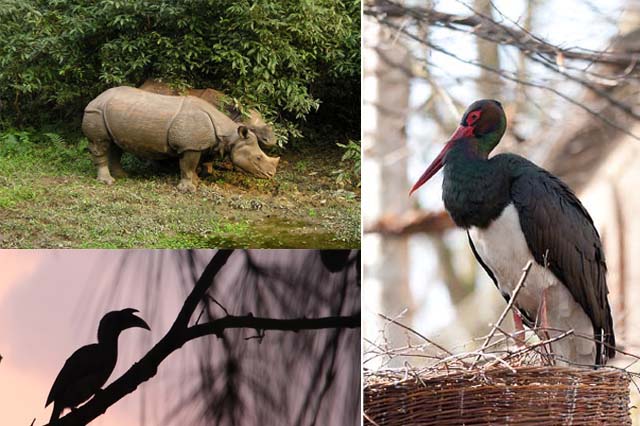Kaziranga National Park: Famous for Birds and Wildlife!

Kaziranga National Park is well-known for the presence of colourful birds and wildlife. In fact, it would not be an exaggeration to say that it is the most famous wildlife tourist destination of Northeast India. People flock from all over the world to enjoy the sights of striking birds and animals.
Situated in the Golaghat, Nagaon and Biswanath districts of Assam, India, Kaziranga National Park is mostly known for having the largest population of one-horned rhinoceroses in the world. However, there are a number of other exotic birds and fauna as well. In fact, in the year 2006, it was declared as a Tiger Reserve. Long before that, the UNESCO declared it as a World Heritage Site in 1985.
So, let us know more about some of the most popular birds and animals of the Kaziranga National Park!
- One-horned rhinoceros
The one-horned rhinoceros is an animal that belongs to the family of Rhinocerotidae. Its scientific name is Rhinoceros Unicornis. It is also popularly known as the great Indian rhinoceros or the greater one-horned rhinoceros. The skin colour of the rhinoceros is greyish brown with a single horn that is black. It is known to have a very thick skin and not much hair. The horn is present in both male rhinos and female rhinos, but not in the newborn ones. There was a time when these rhinos had faced the fear of near extinction, however, they have more or less recovered now, and Kaziranga National Park is considered to be one of the safest places for the vulnerable species.
- Great hornbill
The great hornbill is a bird from the family of Bucerotidae. Its binomial name is Buceros bicornis. Some of its other names are the great pied hornbill and the great Indian hornbill. It is a large and very colourful bird. It is generally 95-120 cm long. The most striking thing about the great hornbill is the yellow casque on top of its bill. They are found in dense forests and are known to live for long with an average life-span of about 50 years. They mostly eat fruits, but occasionally feed on birds and reptiles as well.
- Black-necked stork
The black-necked stork comes from the family of Ciconiidae. Its binomial name is Ephippiorhynchus asiaticus. Other than India and Southeast Asia, it is also found in Australia. The black-necked stork is a tall bird, with its length being 129-150 cm. It is black and white in colour, with its most striking feature is its long bill. The male and the female birds look almost the same, except for the colour of their iris. The females have a yellow iris, while the males have brown. They build their nests in large trees. Once they lay their eggs, they incubate for around 30 days. These are carnivorous birds which feed on aquatic vertebrates, water-birds, and invertebrates as well.
- Wreathed Hornbill
The wreathed hornbill comes from the family of Bucerotidae. Its binomial name is Rhyticeros undulatus. Another name of the wreathed hornbill is bar-pouched wreathed hornbill. It is known as the wreathed hornbill as it has a wreath at the bottom of its bill. It looks similar to the plain-pouched hornbill, the only difference being that it has a bar around its throat. The throat pouch of the male is yellow in colour, while in case of the females, it is blue. They are mostly found in wetlands, grasslands and mountains. They eat fruits, frogs, insects and reptiles.
- Tiger
The tiger belongs to the family of Felidae. Its binomial name is Panthera tigris. The tiger is one of the most recognisable animals in the world, yet over the years its population has largely declined, so much so that it is now considered an endangered species. Poaching is the biggest threat to the existence of tigers. The Kaziranga National Park was officially declared as a Tiger Reserve in the year 2006. Tigers are known to be very strong and agile. It is a majestic looking animal with sharp eyes, black vertical stripes on a combination of white and orange fur.
- Greater Adjutant
The greater adjutant comes from the family of storks, Ciconiidae. Its binomial name is Leptoptilos dubius. The greater adjutant was once found in large numbers in Asia, but over the years its population has greatly declined. The major reason for this decline is habitat loss, along with hunting. It is a really tall bird with its length being 140-150 cm. The most prominent feature in a greater adjutant is its wedge-shaped bill. It also has a long pouch below its neck. They feed on the decaying flesh and organs of dead animals.
- Black-breasted parrotbill
The black-breasted parrotbill is a bird from the family of Sylviidae. Its binomial name is Paradoxornis flavirostris. It is one of the rarest birds in India and is only known to be found in Assam. Over the past few years, it has become even lesser in number. The bird is mostly brown in colour with the upper-breast area being black and the beak being yellow.






